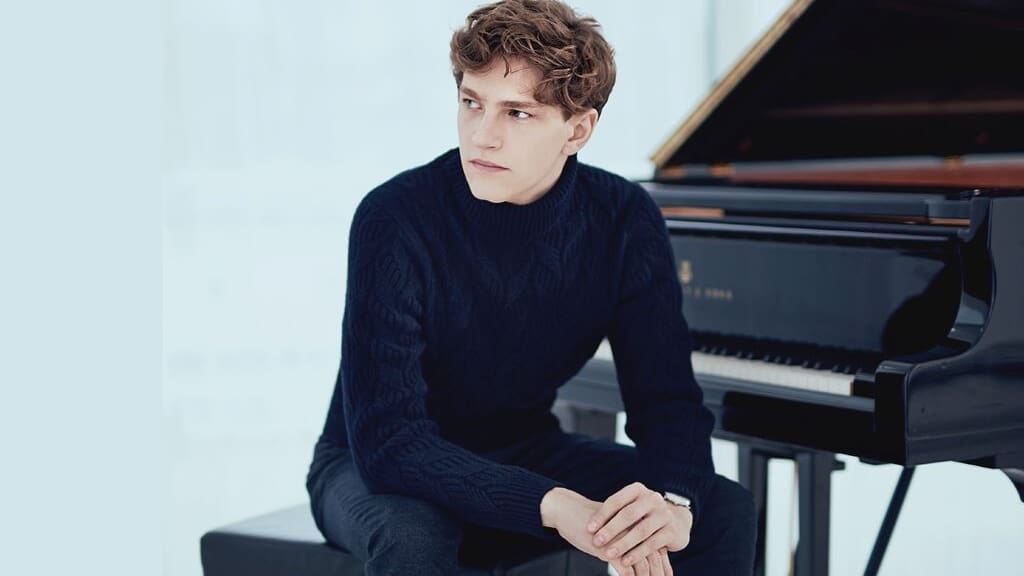Mozart was at the height of his popularity in Vienna when, in March of 1785, he composed the Piano Concerto No. 21 in C Major, K. 467.
In a letter dated March 12, two days after the Concerto’s premiere, Mozart’s father, Leopold, wrote to his daughter back home in Salzburg,
We never get to bed before one o’clock and I never get up before nine. We lunch at two or half past. … Every day there are concerts; and the whole time is given up to teaching, music, composing and so forth. … If only all the concerts were over! It is impossible for me to describe the rush and bustle. Since my arrival your brother’s fortepiano has been taken at least a dozen times to the theatre or to some other house.
Leopold went on to describe the “deafening” applause which followed Mozart’s performance of his newest concerto, and the way in which some listeners were moved to tears. Still, as musicologist Richard Rodda notes,
the sensitive professional musician sensed a disturbing element in much of his son’s recent music. He felt that this Concerto was not only “astonishingly difficult,” but that it also held an expressive undercurrent which would not continue to please the Viennese public. When the copyist dropped off the parts for the work, for example, Leopold questioned him about some of the harmonies, assuming that many of the flats and sharps were in error. They were not, he was assured. These curious new harmonies were what Mozart had written…
Indeed, Mozart’s popularity in Vienna proved to be a passing fad, as can be seen in the number of piano concerti written by year: three in 1782 and 1783, six in 1784, three in 1785 and 1786, and then only one each in 1788 and 1791.
And yet, with these adventurous new works, the modern piano concerto was born. Filled with an operatic sense of conversation, the solo piano became the protagonist of a drama in which the instruments of the orchestra were equal partners. “No formulas bound Mozart,” writes Orrin Howard. “Each concerto, though bearing an unmistakable family resemblance to its siblings, commanded and received specific, thoroughly individual compositional responses.”
Coming close on the heels of the shadowy and tempestuous Concerto No. 20 in D minor, Concerto No. 21 is at once majestic and comic. The comedy is apparent in the tiptoeing opening statement of the first movement (Allegro maestoso). In the final bars, the theme slinks away with a similar clownishness. The movement’s principal theme is a spirited march which musicologist Alfred Einstein believed might have been influenced by La Marseillaise. Shifting abruptly to G minor, a new theme foreshadows the opening motif of Mozart’s Symphony No. 40 in G minor, composed three years later. For Einstein, the development section, “with its modulations through darkness to light,” stands as “one of the most beautiful examples of Mozart’s iridescent harmony and of the breadth of the domain embraced in his conception of C major.”
Famously, the second movement (Andante) was featured in the 1967 Swedish romantic film, Elvira Madigan. It begins with a dreamy and serene theme, played by muted strings. The theme takes a sudden, shadowy turn which is punctuated by aching dissonances before returning to the sunshine, as if nothing out of the ordinary happened. (Perhaps these were among the surprising harmonies which caught Leopold Mozart’s attention). Underlying triplets propel the music forward with a persistent hushed intensity. Combining the tragic and the sensuous, this movement anticipates Romanticism to come.
The concluding rondo (Allegro vivace assai) delivers sparkling virtuosity and the frivolity of opera buffa. There is a witty game of “call and response” between soloist and orchestra. Following a concluding cadenza, the main theme returns with a giddy sense of joy, culminating in the triumphant flourish of the piano’s upward scale.
This concert performance features Canadian pianist Jan Lisiecki, with Andrew Manze and the Chamber Orchestra of Europe:
Five Great Recordings
- Mozart: Piano Concerto No. 21 in C Major, K 467, Jan Lisiecki, Christian Zacharias, Bavarian Radio Symphony Orchestra Amazon
- Mitsuko Uchida with Jeffrey Tate and the English Chamber Orchestra
- Yeol Eum Son with Sir Neville Marriner and the Academy of St Martin in the Fields
- Murray Perahia and the English Chamber Orchestra
- Fazıl Say with Peter Oundjian and the Frankfurt Radio Symphony


“The theme takes a sudden, shadowy turn which is punctuated by aching dissonances before returning to the sunshine, as if nothing out of the ordinary happened.”
Bravo! Well said.